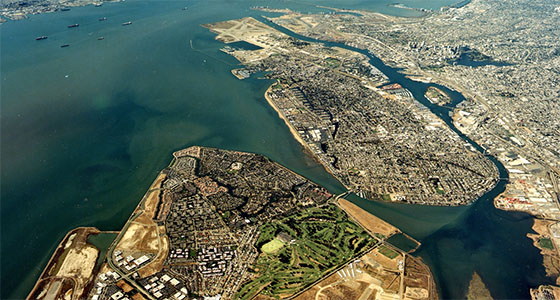I thought I had finished my series of articles about the islands in San Francisco Bay some time ago. But now I realize that if I can do an article about a place that sometimes is and sometimes is not an island (Mare Island), and about a place that was not but is now an island (Alameda), why not an article about a place that once was but is no longer an island?

Alameda’s Bay Farm Island (now a peninsula) can be seen at bottom of photo.
By Captain Ray
Published: December, 2015
I thought I had finished my series of articles about the islands in San Francisco Bay some time ago. But now I realize that if I can do an article about a place that sometimes is and sometimes is not an island (Mare Island), and about a place that was not but is now an island (Alameda), why not an article about a place that once was but is no longer an island?
I am referring to Bay Farm Island. It is located just southeast of Alameda Island, separated from it by San Leandro Bay. The Bay Farm Island Bridge provides access to Alameda. The first bridge in this location was built in 1854, when Bay Farm was still an island. The present bridge was constructed in 1881 and has been in continuous operation ever since.
The Ohlone people gathered food on Bay Farm Island for millennia. With the coming of the Spanish in the 1770s, the use and title of the land changed radically. Land that had been held communally by the Ohlone was transferred to private ownership. Bay Farm Island was part of a very large land grant (stretching from Albany to San Leandro) given to Don Luis Maria Peralta in 1820 as a reward for his years of service in the Spanish army. He divided this grant among his four sons in 1845; Bay Farm Island was part of the 16,000 acres presented to Antonio Maria Peralta.
Europeans had several names for the island, the first of which was Bay Island. In 1873, Amos Mecartney (a major street on the island bears his name) moved to the island and began farming. This inspired Farm Island, another of the early names for the island. Manure from the farm animals mixed with imported dirt helped enrich the sandy soil, and the mild climate allowed for long growing seasons. One crop that did very well was asparagus, which prompted use of yet another name for the land—Asparagus Island.
In the 1880s, the Silva family settled on the island and in 1905 the Ratto family arrived. (Island street names memorialize both of these families.) They farmed the land, growing a great variety of produce in addition to asparagus—including potatoes, many types of lettuce and hops. The Ratto enterprise eventually became Ratto Bros., which later moved to the Central Valley and which still continues to grow produce.
Bay Farm Island was also known for the native Olympia oysters. The shallow waters around the island were once rich with the mollusks, upon which the Ohlone and early San Franciscans feasted. Oakland native Jack London, certainly more famous as an author, was once an oyster pirate. London would make nighttime raids on the oyster beds around Bay Farm Island in his boat Razzle Dazzle. The Olympia oyster beds were quickly destroyed by land fill, silt from hydraulic mining for gold in the Sierra Nevada, introduced oyster species and industrial pollution. Environmental organizations are now attempting to restore these native beds.
Early maps show that Bay Farm was clearly an island, separated from the shoreline of the East Bay by the marshes at the mouth of San Leandro Creek. Island Drive marks the original shoreline of the island. This land (to the east and south of the island) was filled for housing, a golf course and an airport. The fill connected Bay Farm Island to the mainland; it ceased to be an island.
The original Oakland Airport (now called North Field) was dedicated by Charles Lindbergh in 1927. At that time it was the longest runway in the world (just over 7,000 feet) and was the takeoff site for the first commercial flights to Hawai’i as well as Amelia Earhart’s ill-fated attempt to fly around the world. Further filling of the Bay in the 1960s enlarged Bay Farm Island (now a peninsula) and created what is the present Oakland International Airport.

